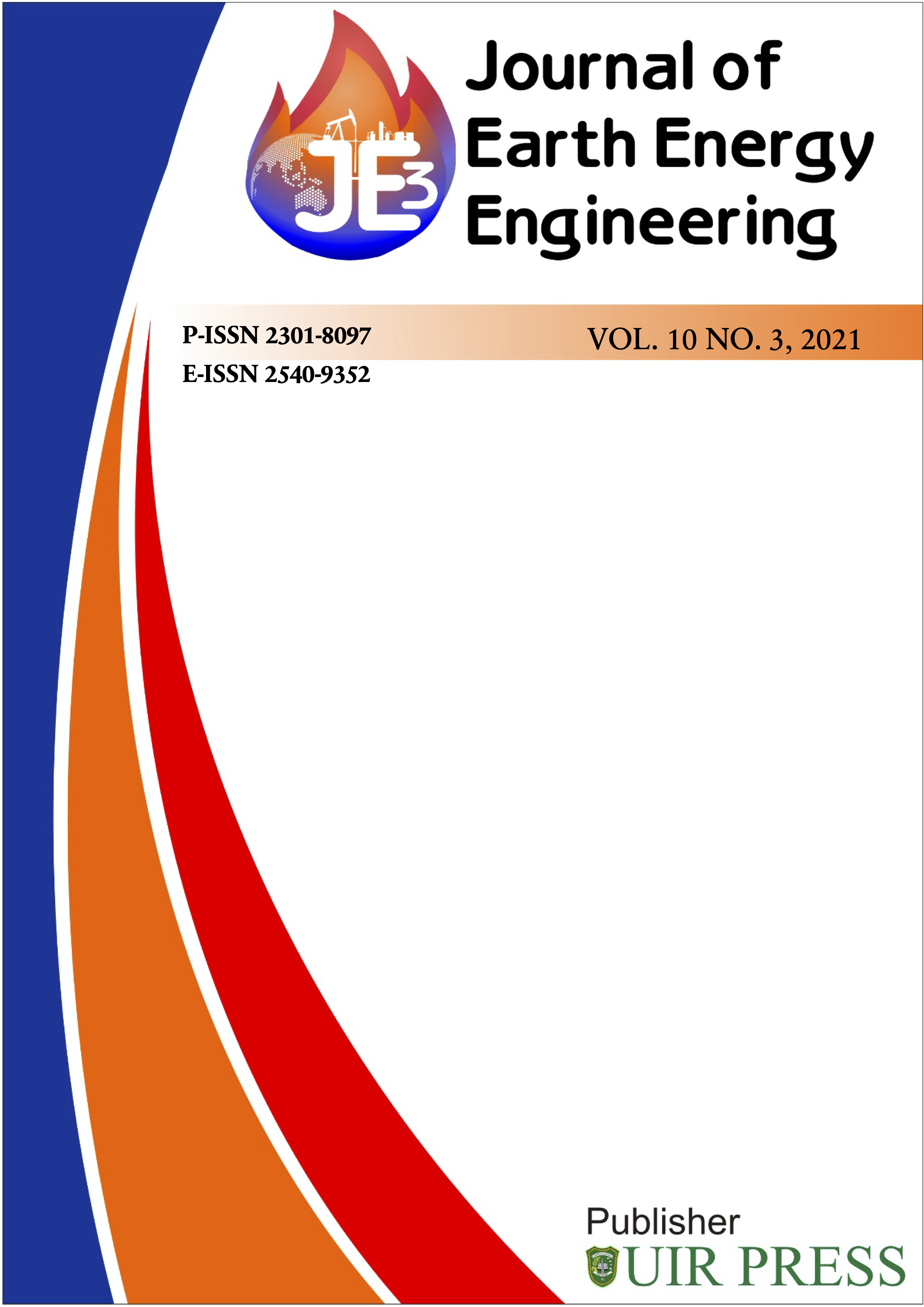Study of Indonesia’s Solar Energy Implementation Using Identification of Potency, Policies, and Cost-Benefit Analysis
Abstract
The solar PV systems are semiconductor devices that precisely convert sunlight into electricity, through the transfer of electrons. They provide several advantages, such as high modularity, zero noise, and adequate availability of solar resources in Indonesia. Therefore, this study aims to determine the potency, policy perspective, and Cost-Benefit Analysis (CBA) of the solar energy implementation for electricity generation. A statistical analysis was used for measuring potency, as well as reviewing opportunistic policies and barriers. A review of some CBA-based journals was also carried out, to determine that the development of solar power electricity had more benefit than fossil fuels and LCOE (Levelized Cost Of Electricity). The results of the 10-days average value calculation in 2019 were 388-563 W/m2, with the maximum values at 1137-1604 W/m2. Meanwhile the analysis of the maximum hourly averages for Western, Central, and Eastern Indonesia were 570-719, 634-758, and 559-627 W/m2 at 11.00-12.00 WIB, 11.00-13.00 WITA, and 12.00-13.00 WIT, respectively. The potency of solar radiation intensity in Indonesia was averagely 150-750 W/m2, as the highest values were found in East Nusa Tenggara, Maluku, and Merauke.
Full text article
References
Abadi, S., Ciptomulyono, U., & Ahmadi. (2016). ANALISA PEMANFAATAN ENERGI TERBARUKAN UNTUK MENDUKUNG KEBUTUHAN LISTRIK DI PULAU ROMANG DENGAN METODE CBA (COST BENEFIT ANALYSIS) DAN ELECTRE (ELIMINATION ET CHOIX TRADUISANT LA REALITE). SEMINAR NASIONAL PASCASARJANA STTAL, 1–7.
BAPPENAS. (2012). Policy Paper Keselarasan Kebijakan Energi Nasional (KEN) dengan Rencana Umum Energi Nasional (RUEN) dan Rencana Umum Energi Daerah (RUED).
Blum, N. U., Sryantoro Wakeling, R., & Schmidt, T. S. (2013). Rural electrification through village grids—Assessing the cost competitiveness of isolated renewable energy technologies in Indonesia. Renewable and Sustainable Energy Reviews, 22, 482–496. https://doi.org/10.1016/j.rser.2013.01.049 DOI: https://doi.org/10.1016/j.rser.2013.01.049
Cai, M., Wu, Y., Chen, H., Yang, X., Qiang, Y., & Han, L. (2017). Cost-Performance Analysis of Perovskite Solar Modules. Advanced Science, 4(1). https://doi.org/10.1002/advs.201600269 DOI: https://doi.org/10.1002/advs.201600269
Eco-Business. (2020). Running out of excuses: Where does Southeast Asia’s energy transition stand in 2020? | News | Eco-Business | Asia Pacific. https://www.eco-business.com/news/running-out-of-excuses-where-does-southeast-asias-energy-transition-stand-in-2020/
Ferroukhi, R., Lopez-Peña, A., Kieffer, G., Nagpal, D., Hawila, D., Khalid, A., El-Katiri, L., Vinci, S., & Fernandez, A. (2016). Renewable Energy Benefits: Measuring the Economics. In International Renewable Energy Agency (IRENA).
Hayati, N. (2021). Aplikasi Tenaga Surya sebagai Sumber Energi Alternatif. ABDIMASKU : JURNAL PENGABDIAN MASYARAKAT, 4(1), 43. https://doi.org/10.33633/ja.v4i1.159 DOI: https://doi.org/10.33633/ja.v4i1.159
KESDM. (2016). First Nationally Determined Contribution Submitted To UNFCCC. November 2016, 1–18.
Malik, S. A., & Ayop, A. R. (2020). Solar energy technology: Knowledge, awareness, and acceptance of B40 households in one district of Malaysia towards government initiatives. Technology in Society, 63, 101416. https://doi.org/10.1016/J.TECHSOC.2020.101416 DOI: https://doi.org/10.1016/j.techsoc.2020.101416
Midford, P., & Moe, E. (Eds.). (2021). New Challenges and Solutions for Renewable Energy. Springer International Publishing. https://doi.org/10.1007/978-3-030-54514-7 DOI: https://doi.org/10.1007/978-3-030-54514-7
Pacudan, R. (2018). Feed-in tariff vs incentivized self-consumption: Options for residential solar PV policy in Brunei Darussalam. Renewable Energy, 122, 362–374. https://doi.org/10.1016/J.RENENE.2018.01.102 DOI: https://doi.org/10.1016/j.renene.2018.01.102
Patricia, H. (2012). Analisis Keekonomian Kompleks Perumahan Berbasis Energi Sel Surya (Studi Kasus: Perumahan Cyber Orchid Town Houses, Depok).
Pratama, A. . (2017). Studi Kelayakan Perencanaan Pemasangan Panel Surya dengan Metode Benefit-Cost Analysis (Studi Kasus pada Fakultas Ekonomi dan Bisnis Universitas Sebelas Maret Surakarta). Universitas Sebelas Maret Surakarta.
Prayogi, E., Prasetyo, E., & Riski, A. (2020). Pemanfaatan Energi Surya Sebagai Sumber Energi Sepeda Listrik. Prosiding Seminar Rekayasa Teknologi, 73–78.
Putri, D. P., & Koenhardono, E. S. (2016). Perencanaan Sistem Pembangkit Listrik Hybrid (Sel Surya dan Diesel Generator) Pada Kapal Tanker. Jurnal Teknik ITS, 5(2), B394–B399. https://doi.org/10.12962/J23373539.V5I2.19318 DOI: https://doi.org/10.12962/j23373539.v5i2.19318
Ramadhan, M., & Naseeb, A. (2011). The cost benefit analysis of implementing photovoltaic solar system in the state of Kuwait. Renewable Energy, 36(4), 1272–1276. https://doi.org/10.1016/J.RENENE.2010.10.004 DOI: https://doi.org/10.1016/j.renene.2010.10.004
Septiadi, D., Nanlohy, P., Souissa, M., & Rumlawang, F. Y. (2009). PROYEKSI POTENSI ENERGI SURYA SEBAGAI ENERGI TERBARUKAN (STUDI WILAYAH AMBON DAN SEKITARNYA). Jurnal Meteorologi Dan Geofisika, 10(1), 22–28. https://doi.org/10.31172/jmg.v10i1.30 DOI: https://doi.org/10.31172/jmg.v10i1.30
Setiartiti, L., & Hisjam, M. (2019). Implementation and institutional development for solar power plants management in Yogyakarta, Indonesia. AIP Conference Proceedings, 2097(1). https://doi.org/10.1063/1.5098274 DOI: https://doi.org/10.1063/1.5098274
Setyawati, D. (2020). Analysis of perceptions towards the rooftop photovoltaic solar system policy in Indonesia. Energy Policy, 144, 111569. https://doi.org/10.1016/J.ENPOL.2020.111569 DOI: https://doi.org/10.1016/j.enpol.2020.111569
Solangi, K. H., Islam, M. R., Saidur, R., Rahim, N. A., & Fayaz, H. (2011). A review on global solar energy policy. Renewable and Sustainable Energy Reviews, 15(4), 2149–2163. https://doi.org/10.1016/j.rser.2011.01.007 DOI: https://doi.org/10.1016/j.rser.2011.01.007
Sugiyono, A. (Agency for the A. and A. of T. (2001). Renewable Energy Development Strategy in Indonesia: CDM Funding. THE 5TH INAGA ANNUAL SCIENTIFIC CONFERENCE & EXHIBITIONS, 64–69.
Syahbana, R. A. (2012). Percobaan Pendahuluan Pemanfaatan Energi Surya sebagai Energi Alternatif Sistem Kelistrikan Lampu Navigasi pada Kapal Penangkap Ikan. Institut Pertanian Bogor.
Tharisung, K. (2020). Economic Cost of the Feed - in - Tariff (FiT) in Thailand. International Journal of Energy Economics and Policy, 10(4), 356–363. https://doi.org/10.32479/IJEEP.9367 DOI: https://doi.org/10.32479/ijeep.9367
Veldhuis, A. J., & Reinders, A. H. M. E. (2015). Reviewing the potential and cost-effectiveness of off-grid PV systems in Indonesia on a provincial level. Renewable and Sustainable Energy Reviews, 52, 757–769. https://doi.org/10.1016/j.rser.2015.07.126 DOI: https://doi.org/10.1016/j.rser.2015.07.126
Authors
This is an open access journal which means that all content is freely available without charge to the user or his/her institution. The copyright in the text of individual articles (including research articles, opinion articles, and abstracts) is the property of their respective authors, subject to a Creative Commons CC-BY-SA licence granted to all others. JEEE allows the author(s) to hold the copyright without restrictions and allows the author to retain publishing rights without restrictions.




